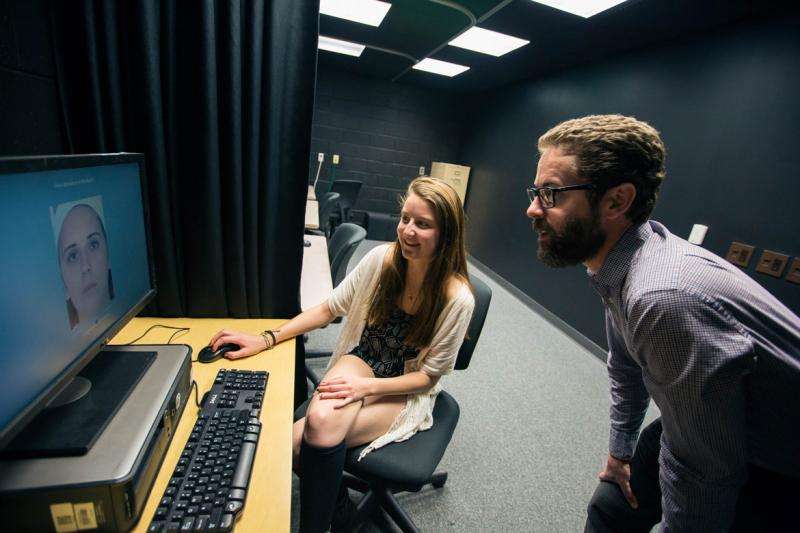The psychology of makeup

You are five years old, playing with your friends outside, when suddenly someone new appears. You size them up and realize they must be two or maybe even three years your senior. You give up your swing as a sign of respect. Playground politics.
You are thirteen years old, begrudgingly attending a family reunion. Across the mile-long dinner table sits a relative you've never met before. You infer from her grey hair and wrinkled face that she must be someone's great, or possibly great, great-aunt.
We spend our days making assumptions and understanding one another on the basis of appearance. We unconsciously use height, hair color, and facial cues as indicators of age and attractiveness. But how and why?
Psychology Prof. Richard Russell devotes his time to investigating these very questions. Combining his passion for visual art with a biologically based method of studying human behavior, Russell is interested in learning more about how and why we perceive one another.
"We have, not just one part of the brain, but a whole network of regions in the brain that seem to be dedicated to perceiving faces," said Russell. "We get a lot of information from faces; we spend our waking hours looking at faces. And it's not because we don't have anywhere else to look but because it's such a rich source of social information."

Most recently, Russell has shifted his focus to study how we perceive health from the face. His research is aimed at identifying and analyzing the visual cues we use to decide how healthy we think a person is based on their appearance.
Russell, along with a team of researchers, took 150 photos of women between the ages of 56-60 years old—controlling for demographic variables like age and gender as well as for photogenic conditions. Using and manipulating these images, Russell and his team came up with a list of questions that asked individuals to evaluate how healthy they thought these women appeared.
The results indicate that there are key facial cues we use that impact how we perceive facial health. The first is facial contrast—the more contrast between facial features such as the eyes and lips, the healthier the person appears. They also found that skin coloration, particularly the coloration under the eyes and on the cheeks, influences our perception of facial health. Rosier cheeks are signs of a healthy individual, while dark bags under the eyes might suggest the opposite. Finally, facial expressions greatly impact how healthy we think someone might be. As it turns out, healthiness is predicated on happiness. People perceived as happier, were perceived as healthier, as well.
A natural extension of this type of research includes an attempt to answer the questions: how and why do humans decorate themselves? Can we cosmetically change the way we look to appear healthier?
Russell is especially interested in exploring this research question and better understanding the cultural use of makeup in society.
"Hundreds of millions of people are applying makeup every day. That suggests to me that there's something important about it," said Russell. "It's a part of understanding who we are as people. Why are we putting on makeup, what are we getting out of it, and how does that work?"
While we may not understand how makeup works on a theoretical level, it is working perceptually—it changes people's perception of the face in a mostly positive direction. And it does so by targeting those key facial cues we use to judge healthiness and appearance. Makeup can increase facial contrast and affect skin coloration—thus helping us appear healthier.
"One nice thing about visual perception is that you have a physical variable, like contrast. And we are pretty accurate at measuring physical variables," said Russell. "We have been doing it for hundreds of years and know our way around it. With psychological variables, it's very difficult to study them because they're so abstract."
In addition to investigating this topic outside of the classroom, Russell also teaches a class and an advanced lab in sensation and perception that examines questions related to visual preference. For example, why do we like looking at some things more than others?
"Being actively engaged in research shapes how we, as professors, teach. We're not reading about research from someone else, we're engaged in the process of expanding our knowledge of a particular topic."
Working at the interface of facial health and visual perception is especially fun for Russell, whose decision to study the psychology of the brain was sparked by a developing interest in visual arts—particularly painting and photography. And while it might not seem like Russell is doing visual art now, he has come to find that there is a great deal of visual creativity involved in the research he conducts, research he hopes will some day make a difference in how we understand and use our makeup products.
"Some people study how you can help people live longer, and other people study how you can make it more worthwhile to be alive, and I think of my research as being in that latter category—it's something that helps make life interesting and beautiful."

















